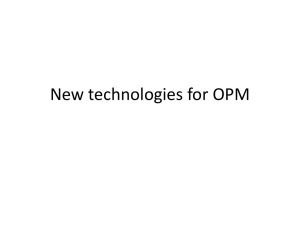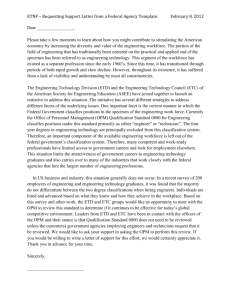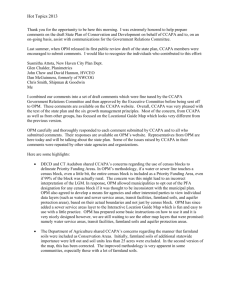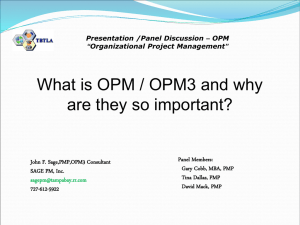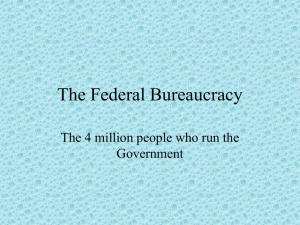Short Term Time Off Options for Federal
advertisement
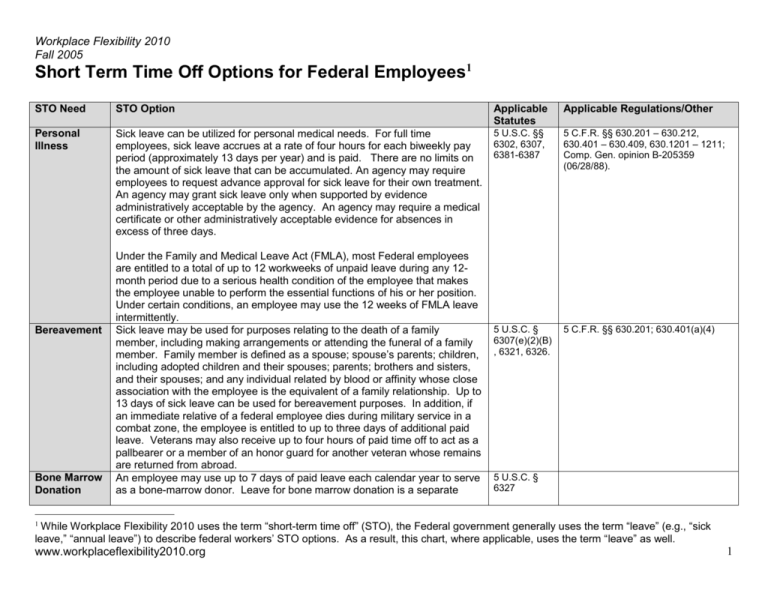
Workplace Flexibility 2010 Fall 2005 Short Term Time Off Options for Federal Employees1 STO Need STO Option Applicable Statutes Applicable Regulations/Other Personal Illness Sick leave can be utilized for personal medical needs. For full time employees, sick leave accrues at a rate of four hours for each biweekly pay period (approximately 13 days per year) and is paid. There are no limits on the amount of sick leave that can be accumulated. An agency may require employees to request advance approval for sick leave for their own treatment. An agency may grant sick leave only when supported by evidence administratively acceptable by the agency. An agency may require a medical certificate or other administratively acceptable evidence for absences in excess of three days. 5 U.S.C. §§ 6302, 6307, 6381-6387 5 C.F.R. §§ 630.201 – 630.212, 630.401 – 630.409, 630.1201 – 1211; Comp. Gen. opinion B-205359 (06/28/88). 5 U.S.C. § 6307(e)(2)(B) , 6321, 6326. 5 C.F.R. §§ 630.201; 630.401(a)(4) Bereavement Bone Marrow Donation Under the Family and Medical Leave Act (FMLA), most Federal employees are entitled to a total of up to 12 workweeks of unpaid leave during any 12month period due to a serious health condition of the employee that makes the employee unable to perform the essential functions of his or her position. Under certain conditions, an employee may use the 12 weeks of FMLA leave intermittently. Sick leave may be used for purposes relating to the death of a family member, including making arrangements or attending the funeral of a family member. Family member is defined as a spouse; spouse’s parents; children, including adopted children and their spouses; parents; brothers and sisters, and their spouses; and any individual related by blood or affinity whose close association with the employee is the equivalent of a family relationship. Up to 13 days of sick leave can be used for bereavement purposes. In addition, if an immediate relative of a federal employee dies during military service in a combat zone, the employee is entitled to up to three days of additional paid leave. Veterans may also receive up to four hours of paid time off to act as a pallbearer or a member of an honor guard for another veteran whose remains are returned from abroad. An employee may use up to 7 days of paid leave each calendar year to serve as a bone-marrow donor. Leave for bone marrow donation is a separate 5 U.S.C. § 6327 While Workplace Flexibility 2010 uses the term “short-term time off” (STO), the Federal government generally uses the term “leave” (e.g., “sick leave,” “annual leave”) to describe federal workers’ STO options. As a result, this chart, where applicable, uses the term “leave” as well. 1 www.workplaceflexibility2010.org 1 Workplace Flexibility 2010 Fall 2005 category of leave that is in addition to annual and sick leave. Agencies are responsible for informing their employees of the entitlement to leave for bone marrow donation. Care of a family member with a serious health condition Care of a family member with routine medical needs Most Federal employees may use a total of up to 12 administrative workweeks of sick or annual leave each year to care for a family member with a serious health condition. Serious health condition is defined as an illness, injury, impairment, or physical or mental condition that involves inpatient care in a hospital, hospice, or residential medical care facility; or continuing treatment by a health care provider. If an employee does not have 12 weeks of sick and annual leave combined available, the employee can take the remainder of the 12 week period as unpaid time off. Federal employees can use up to 13 days of sick leave each year to accompany children to routine medical or dental appointments, such as annual checkups or vaccinations. In addition, OPM policy, at the direction of a Presidential Memorandum, allows up to an additional 24 hours of unpaid leave for such purposes. This includes care for elderly relatives as well. Incapacity due to death of spouse An agency has the discretion to grant sick leave due to severe and physically incapacitating emotional injury following the death of a spouse. Holidays Federal employees are entitled to paid time off for the following holidays: New Year's Day, Birthday of Martin Luther King, Jr., Inauguration Day (if applicable), Washington's Birthday, Memorial Day, Independence Day, Labor Day, Columbus Day, Veterans Day, Thanksgiving Day, and Christmas Day. If www.workplaceflexibility2010.org 5 U.S.C. §§ 6381, 6382 5 C.F.R. § 630.1203 5 U.S.C. § 6307(e)(2) 5 C.F.R. § 630.401; Memorandum from William Clinton, President of the United States, to the heads of executive departments and agencies (Apr. 11, 1997) (available at http://www.opm.gov/oca/ leave/HTML/fampres.htm); Memorandum from James B. King, Director, Office of Personnel Management, to the heads of executive departments and agencies (Apr. 14, 1997) (available at http://www.opm.gov/oca/leave/HTML/fa milylv.htm); OPM, Questions and Answers on the President’s Memorandum on Expanded Family and Medical Leave Policies, April 17, 1997 (available at http://www.opm.gov/oca/ leave/HTML/famqa.htm) Comp. Gen. Opinion B-207444 (10/20/82) 5 U.S.C. §§ 6103, 6104 5 C.F.R. §§ 610.201, 610.202; Comp. Gen. Opinion B-187520 (02/22/77); 56 Comp. Gen. 393 (1977) 2 Workplace Flexibility 2010 Fall 2005 Court Attendance the holiday falls on a weekend, the immediately proceeding workday is considered a paid holiday. A Federal employee is entitled to paid leave to serve as a juror in federal or state court, or as a witness on behalf of any party in connection with any judicial proceeding to which the United States, the District of Columbia, or a State or local government is a party. School Involvement OPM policy allows up to 24 hours of unpaid leave to allow employees to participate in school activities directly related to the educational advancement of a child (not necessarily their own child). This includes: parent-teacher conferences, meetings with child-care providers, interviewing for a new school or child-care facility, or participating in volunteer activities supporting the child's educational advancement. Schools include an elementary school, secondary school, Head Start program, or a child-care facility. Vacation Accrual of paid vacation (annual) leave is based on seniority. Federal employees with less than three years of service receive approximately 13 days of paid annual leave per year, employees with between 3 to 15 years of service receive approximately 20 days of paid annual leave, and employees with 15 or more years of service receive approximately 26 days. If not used, annual leave for most federal employees accumulates for use in succeeding years until it totals not more than 45 days. While there is no specific statute or regulation requiring time off for volunteer activities for federal workers, OPM has issued guidance advising agencies regarding how to provide such time off using existing policies such as annual leave, leave without pay, compensatory time off, and/or, in very limited and unique circumstances, excused absence. This guidance stems from a Volunteer Activities www.workplaceflexibility2010.org 5 U.S.C. §§ 5515, 5537, 6322 5 U.S.C. §§ 6303, 6304 Memorandum from William Clinton, President of the United States, to the heads of executive departments and agencies (Apr. 11, 1997) (available at http://www.opm.gov/oca/ leave/HTML/fampres.htm); Memorandum from James B. King, Director, Office of Personnel Management, to the heads of executive departments and agencies (Apr. 14, 1997) (available at http://www.opm.gov/oca/leave/HTML/fa milylv.htm); OPM, Questions and Answers on the President’s Memorandum on Expanded Family and Medical Leave Policies, April 17, 1997 (available at http://www.opm.gov/oca/ leave/HTML/famqa.htm) 5 C.F.R. §§ 630.301 – 630.308 Memorandum from William Clinton, President of the United States, to the heads of executive departments and agencies (Apr. 22, 1998) (available at http://www.opm.gov/ oca/compmemo/1998/CPM98-V1.asp); 3 Workplace Flexibility 2010 Fall 2005 Clinton Presidential Memorandum directing that “[e]ach department and agency should review its work scheduling practices and make maximum use of existing flexibilities to allow Federal employees to plan and take time off to perform community service as the public business permits.” These policies have continued under the Bush administration. Memorandum from Janice R. Lachance, Director, Office of Personnel Management, to the heads of executive departments and agencies (Apr. 23, 1998) (available at http://www.opm.gov/ oca/compmemo/1998/CPM98-V2.asp); Memorandum from Kay Coles James, Director, Office of Personnel Management, to the heads of executive departments and agencies, CPM 200204 (Apr. 23, 2002) (available at http://www.opm.gov/oca/compmemo/1 998/CPM98-V2.asp) * Portions pulled from the Office of Personnel Management, Leave Administration Website (available at http://www.opm.gov/oca/leave/) www.workplaceflexibility2010.org 4
